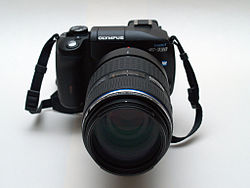- Olympus E-330
-
Olympus E-330 
Type Digital single-lens reflex Sensor 17.3 x 13.0 mm Four Thirds System Live MOS sensor
2x FOV cropMaximum resolution 3136 x 2352 (7.4 effective Megapixels) Lens Interchangeable Four Thirds mount Flash Built in Pop-up, Guide number 13m at ISO 100, hotshoe Shutter Computerised focal-plane shutter Shutter speed range 1/4000 sec - 60 sec
Bulb mode (up to approx. 8 minutes)
1/180s X syncExposure metering TTL open-aperture metering system Exposure modes Program automatic
Aperture automatic
Shutter automatic
Manual setting
Scene programme
Scene selectMetering modes Digital ESP metering (49-point multi pattern)
Centre weighted
Spot (approx. 2%)
Spot with Highlight control
Spot with Shadow controlFocus areas 3-point TTL Phase Difference Detection System Focus modes Single AF ( S-AF )
Continuous AF ( C-AF )
Manual Focus ( MF )
S-AF + MF
C-AF + MFContinuous shooting 3 frame/s up to 4 RAW/TIFF images or
(depending on memory card size, battery power, picture size, and compression)
JPEGViewfinder Optical 0.93x Porro prism ASA/ISO range ISO 100 to 400 in 1/3, or 1.0 EV steps
Limiter for 800 or less / expandable 1600Flash bracketing 3 frames in 1/3, 1/2, 2/3, or 1EV steps Focus bracketing 5/7 frames ( 2-step focusing available in each mode ) Custom WB 7 settings ( 3000K - 7500K )
+/-7 steps in each R-B/G-M axisWB bracketing 3 frames. 2/4/6 steps selectable in each R-B/G-M axis Rear LCD monitor 2.5" (63.5 mm) TFT LCD, 215,000 pixels Storage CompactFlash Type I/II, Microdrive, xD-Picture Card Battery BLM-1 Li-ion battery Weight Approx. 550g ( body only) The Olympus E-330 is a DSLR launched on 30 January 2006, using the Four Thirds System lens mount standard. Its main feature is its live image preview functionality, permitting an image to be previewed on the LCD screen. While live image preview is not new in compact digital cameras, the E-330 is significant because it was the first digital SLR to offer this feature. With the ability to digitally zoom in 10× before taking a picture, it is very well suited for exact manual focussing, for example in macro photography.
Unlike many other digital SLRs, the E-330 used a second sensor in the viewfinder chamber which was fed by splitting 20% of the light from the viewfinder. The advantage of this implementation is that the camera's autofocus and exposure systems are fully functional and there is no shutter lag. The E-330 also offers a liveview mode using the main sensor however in this mode autofocus is disabled and there is additional shutter lag due to the extra close/open at the beginning and the end of the exposure cycle. Sony have adopted a similar liveview implementation in their digital SLRs which also place a second sensor in the viewfinder chamber although a moving mirror to allow all light to go to this sensor avoids the dark viewfinder problem the e-330 suffered from.
The E-330 also offers an 7.5-megapixel image sensor, and has an articulated LCD monitor which tilts up and down for waist-level and over-the-head photography.
The E-330 uses Olympus' patented Supersonic Wave Filter dust reduction system to shake dust from the sensor during startup and when requested by the user; this largely eliminates the problem of dust accumulation on the surface of the image sensor.
The camera offers the following "scene" modes: Portrait, Landscape, Landscape + Portrait, Night Scene, Night + Portrait, Children, Sport, High Key, Low Key, D Image Stabilization, Macro, Nature Macro, Candle, Sunset, Fireworks, Documents, Panorama, Beach & Snow, Underwater Wide, Underwater Macro.
The Panasonic Lumix DMC-L1 and the Leica Digilux 3 are both built using the same basic inner mechanism from the Olympus E-330, and thus also share the live preview function. Unlike the E-330 however, neither the L1 or Digilux 3 incorporated the second sensor in the viewfinder chamber and could only produce the liveview output from the main sensor. They still suffered from the same darker viewfinder as they shared the same mirror to divert 20% of the light for the non-existent secondary sensor.
External links
- Specifications
- Green background indicates cameras with in-body stabilization.
Categories:- Camera stubs
- Olympus DSLR cameras
- Live-preview digital cameras
- Four Thirds System
Wikimedia Foundation. 2010.
